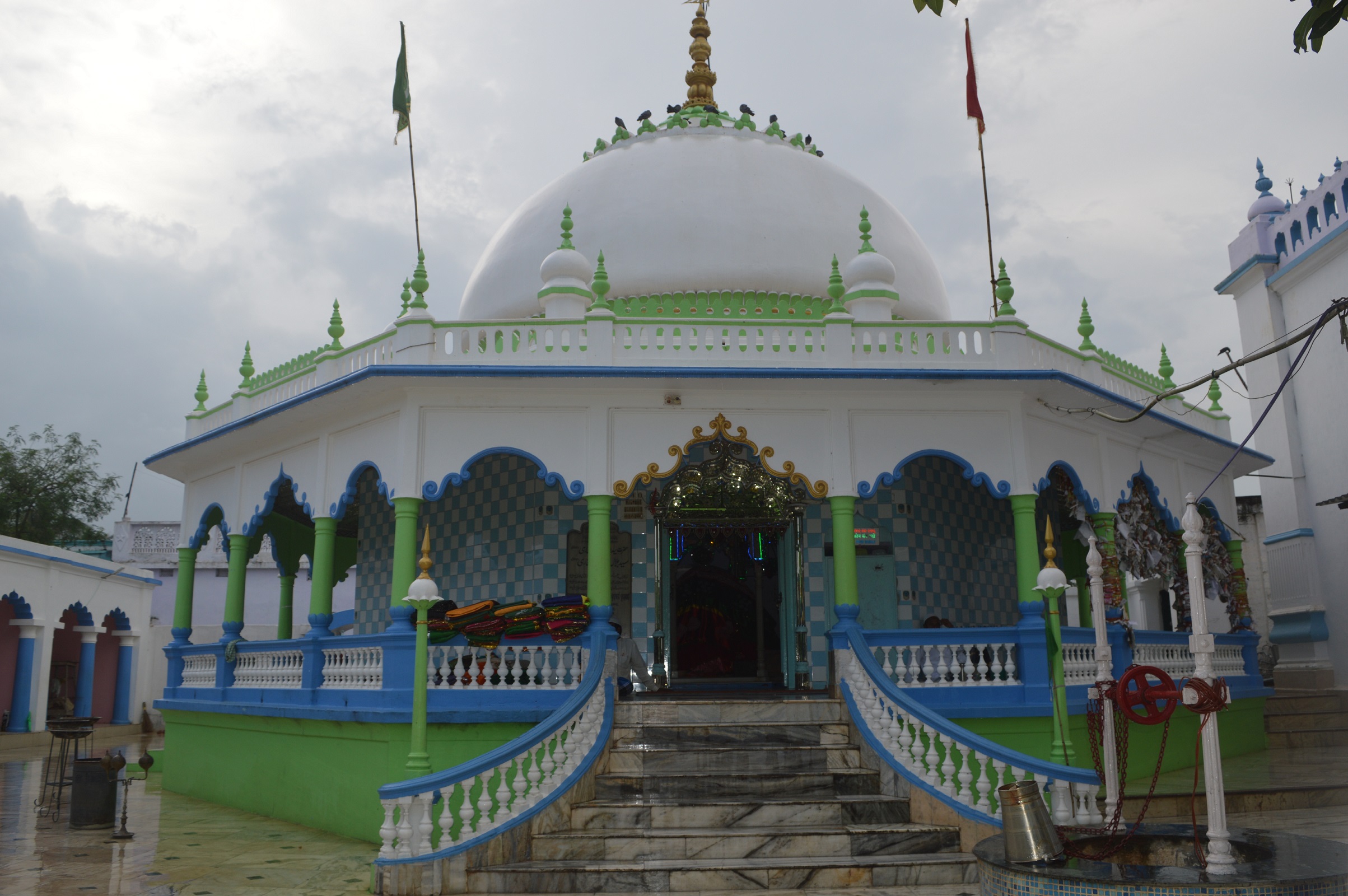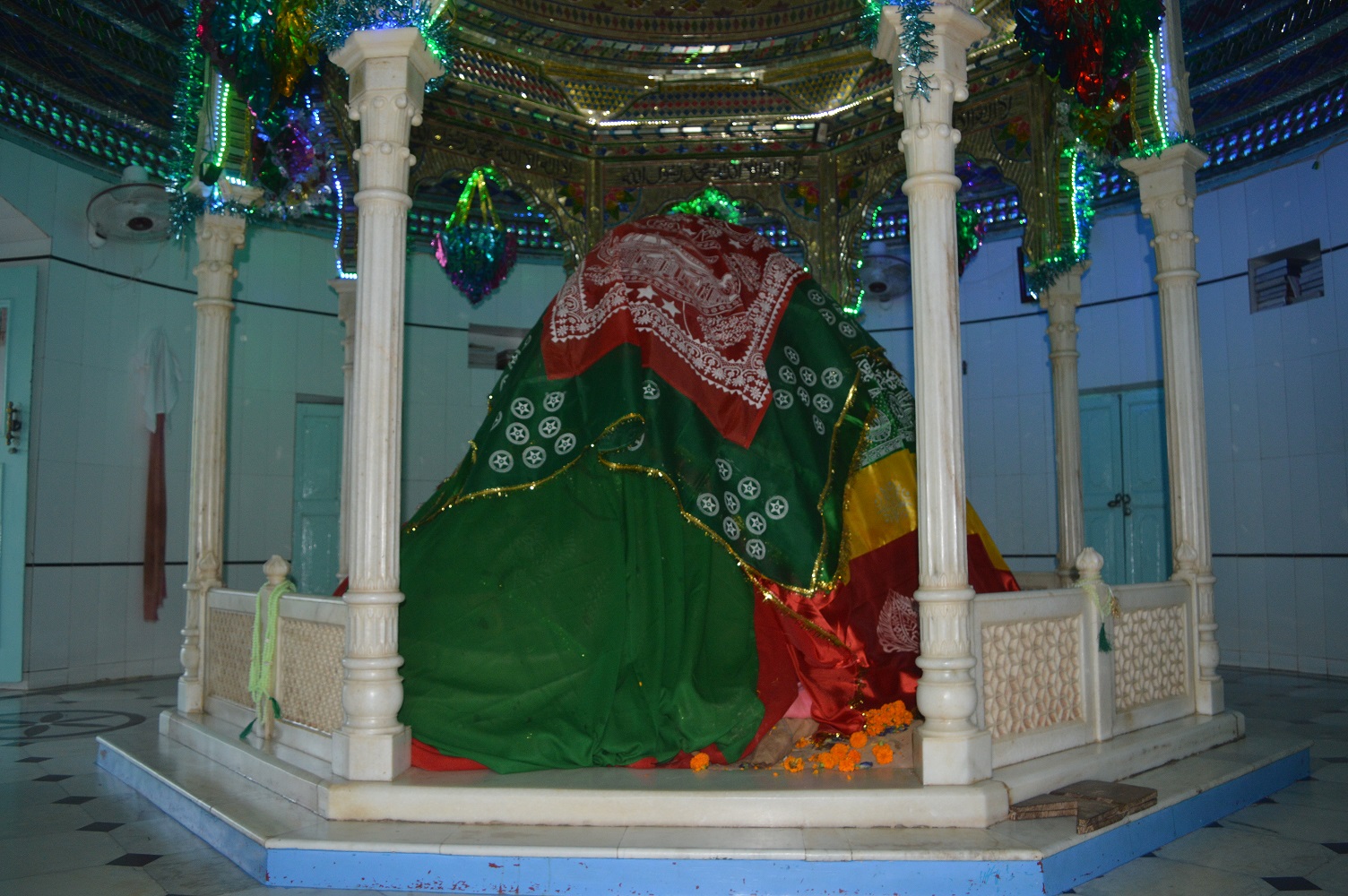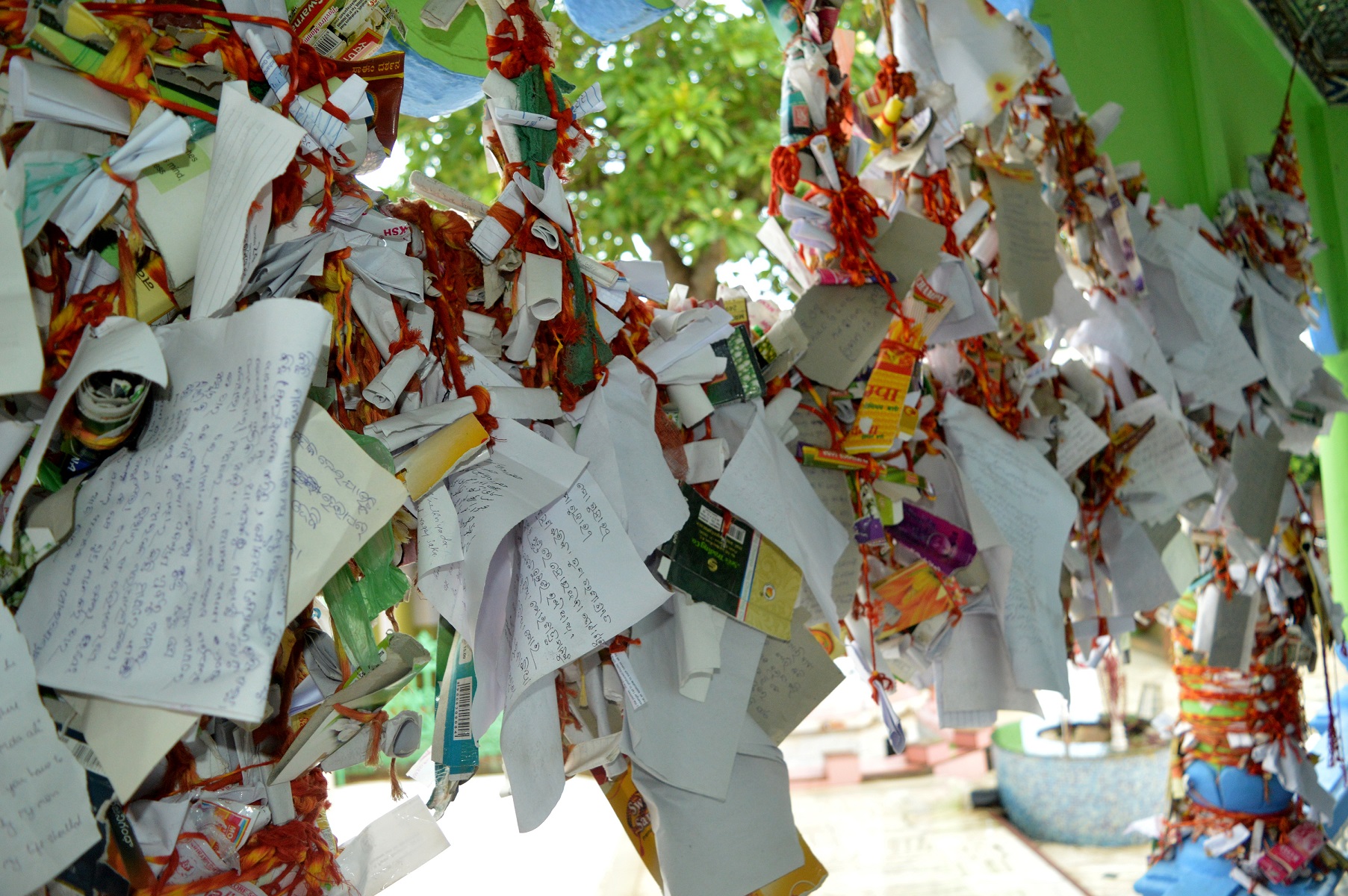If you are interested in Hindu-Muslim relations in Odisha, you must go to Kaipadar to the shrine of a Pir. It is the most famous Pir shrine in Odisha. There the Prasad maker is a Hindu and must be a Hindu, he can’t be a Muslim. Both Hindus and Muslims go to this Pir.
Kaipadar, not far from the city of Khordha, is a village of about 5000 inhabitants, about 1/5th of whom are Muslims. The Pir’s shrine is in a rather elaborate structure surrounded by a large court-yard with adjoining rooms. Next to that compound is a Mosque. As we entered the gate to the courtyard a garland seller (Mali) was selling flowers on the right and a sweet seller gudia was on the left. The Mali’s name is Mahapatra and the gudia’s name is Sahu, both Hindu names. I brought a garland, some sweets incense and rosewater and we went to the shrine. The Khadim sat by a huge termik mound covered with cloth and garlands. The Khadim prayed in Urdu and sprinkled the rose water on the mound. He then blessed us both by brushing us with a bunch of peacock feathers.
Bokhari Baba, the Pir was addressed in a pamphlet entitled Bukhari Baba of Kaipadar written by Trinath Srichandan.
Satya Narayan became Satya Pir for the Muslim. Bukhari Baba was a Sanyasi and came from Samarkand in the 17th Century. He was born in a Muslim family in Bokhara. His name has spread throughout Odisha and throughout India. He was believed to be Ishwar Premi and Ishwar devotee. He was not tied to the world, and he took to sanyas and wandered to different Tirthas. He had been to Mecca and Medina and then he came to India, Delhi, Ajmer, Meerut, Gujrat and then Odisha. From Sterling’s history we know that in 1953 the fort of Kaipadar was established earlier surrounded by Jungle. Baba entered there in the afternoon. At noon he did Namaz. For purification he needed water, so Baba met a long bearded, knotted hair Sadhu and asked him for water. The Sadhu knew that Baba was a Siddha Purusha. To test he told him that he had no water and advised him to get it himself. Baba had an iron rod in his hand and struck the earth with it. Water gushed out. The water is seen in the well in the courtyard of the shrine. The two stayed in the same place in the discussion of spiritual texts and philosophy. The Sadhu then left for a tirth Baba stayed there in this beautiful forest with fruits and flowers. He was old and practising meditation.
Gajapati Ramachandra Deva (the then King) was staying in the historic Barunei Hill. Once the King was hunting near Kaipadar fort and met the Baba. The King felt blessed seeing the Baba. Taking the permission from Baba the king built an ashram there and arranged for his food and drink in the flowered forest. The fame of Bukhari Baba spread everywhere. Baba was equally affectionate to the Hindus and Muslims. People got satisfaction from having Darshan. Baba gave Hukum (Order) fulfilled the desires of the devotees Baba shared with others the food and drink the king had given him. A cowherd boy, learning of the great deeds of Baba, offered milk regularly. Many people began staying there so a settlement grew in that area. The cowherd boy saw that while meditating an ant-hill was forming around Baba. He ran to the village and told the news. The villagers came and saw the Baba in deep meditation a brilliant glow on his face. They had their last Darshan and people offered flowers. Then the covered him completely and a hill grew. So he is a Zinda Pira ( living Pir). He is the great devotee of Khuda (Allah).
The news spread to Khordha and the Gajapati came with his courtiers and realised that Baba is Satya Pir. The Gajapati Ramachandra Deva introduced the Puja for the Union of the Hindu and Musilim religion and culture. Since that time the Hindu Satya Narayan’s peacock tail is kept at the Shrine. A Sahu Mahajan was appointed for offering dried sweet. A mali was appointed for supply of flowers and sandal paste. Every day this is offered to the Pir. The Fakirs who came are to be fed on Thursdays with Khiri and Khechuri. The King donated 2 batis (about 8 acres) and 10 manas ( 2 acres) of land in the month of Jyestha (1734). This is known from one of the Sanand, (Decrees) from the kings Court.
Sanand, (Decrees) from the kings Court. In Benitangi a nearby village, there is a well out of which Babas Bibhuti (sacred ash) comes. The soil has a good smell and looks like sandal paste. When the Puja started Baba appeared in a dream to the Khadim and told him about the Bibhuti from the well of a gudia. At the time of the offering the clay from the particular well is put in the sirini, it will become Prasad. The Khadim and the villagers went there and found the clay.
At dawn, the main door is opened. After ablutions, the Khadim plays the Nagara (drum). The door to the shrine is opened and the shrine is cleaned. The mali and the Gudia arrange their flowers and sweets. The Khadim offers sandal paste and flowers and lights a ghee lamp. Then sirki is offered. In the evening the drum is also played and the incense of offered. The shrine is open till 9 p.m. Thursday is a holy day. Khiri is given to the poor and the Fakirs are fed. Several annual festivals are observed such as Iurs, Ramzan etc.
There is no feeling of touchable or untouchable caste. Everyone can come and eat together. The Quran is recited on holy days. Muslims and Hindus forget their differences and live like brothers.
Satya Narayan Pala is performed here. The flag on the shrine is a symbol of the equality of Hindu and Muslim culture.
The present marble shrine was constructed in 1893 in Muslim style. The money was donated by a seafaring trader who received a boon from Baba. The architect Dohasasana Mangaraja was a Hindu. The villagers offered their labour and a new to temple was built in 1925. Ramachandra brought a Khadim from Kurupala. (Near Khordha). The information in the pamphlet confirmed what the Mali, the Gudia had told me. They confirmed that land was given to them by Ramachadnra Dev to perform the seva of the Baba.
The author of the pamphlet, Trinath Srichandan, being a Hindu uses throughout his Hindu terms such as Sanyasi, Pujak, tirth, samsar, iswar premi, Bhagavad Bhakti and siddh person to talk of Bukhari Baba. The first phase informs the readers that the Muslim Satya Pir is a form of Satya Narayan. Ramachandra endowed land to both Hindus and Muslim servitors for the worship at the shrine. This simply institutionalized the popular practice. He simultaneously gave state legitimacy to harmonious relations between the two communities. The popular practice had not changed since the co-operation of the two communities. The popular practice remained unchanged till date.
Pala is performed by particular Hindu sect for the fulfilment of people’s desires. The singer who lives in a 15kms. radius from the shrine come to get the Baba’s blessings and take permission before they start to perform. They carry a bunch of peacock feathers and these are said to represent simultaneously Satya Narayan and Satya Pir who in fact are one and the same as it is the same peacock feather that Khadim uses to bless the visitors coming to the shrine. The Muslims do not sing nor do they sponsor Pala.
Khordha, therefore remained the hub of political, social, cultural and religious life of Odisha for long time. Muslim padas or Bustee, grew at different places around Khordha. There are certain predominantly Muslim inhabited areas that bear testimony to the spirit of communal harmony between Hindus and Muslims each participating and practising the rituals of the other community. Kaipadar, about 14kms, from Khordha has a population of over 4,000 of which 1/5th are Muslims. It is famous for the holy Bukhari Baba’s shrine, which is a unique place of worship for the Hindus and Muslims. Devotees from all over the country and abroad visit this shrine to offer their obeisance to Satyapir. While offering the Bhoga, a big drum like instrument is beaten which is prohibited in other Muslim rituals. Every year the 24th day of Ramzan is observed. On this day the Khadim sprinkles rose water on Baba’s Samadhi and covers it with a new canopy accompanied by the slogan of Haribol by the Hindus and Alha-Akbar by Muslims. Hindus perform Nam Sankritan and Muslims recite the Quran and organize quwalis.
Although this is mainly a Muslim festival the devotees comprise a large section of the Hindus. Hindus observe Satyanarayan Pala, whose concept has been derived from Hindu God, Satyanarayan and the Islamic Pir. It is believed that if a deevote writes his wishes on a piece of paper and hangs it in the shrine, his wishes are fulfilled.
.As history reveals, Odisha permanent relationship with Muslims began only in 1568 when Kalapahar, the general of the Afghan ruler of Bengal defeated Mukunda Deva, the last independent Hindu king of Odisha. The Mughals replaced the Afghans in 1578 and continued to rule for about two centuries. The Muslim conquest of Odisha was not only late chronologically compared to other regions of India, but it also failed to attain the strength and permanence as it did in neighbouring Bengal. Islam failed to penetrate among the Muslim population. In Odisha conversion did not take place on a large scale.
Although he embraced Islam, the Raja of Khordha Ram Chandra Deva II tried to protect Jagannath from falling into the hands of the invading army of the Subedar of Bengal, Bihar and Odisha. As the Madalapanji records, he was allowed to perform ritual services to Jagannath despite being a convert. Moreover, Sufism gained popularity in Odisha and led to the emergence of Satyapir tradition. Even today Hindus worship Satyanarayan and Pir together, which is an example of the synthesis of Sufism and Hinduism.
References:
1. The pamphlet of Bukhari Baba of Kaipadar written by Tunath Srichandan.
2. Odisha Review, 2005
Article was written by Sasmita Pattanaik and was first published on Odisha Government magazine



